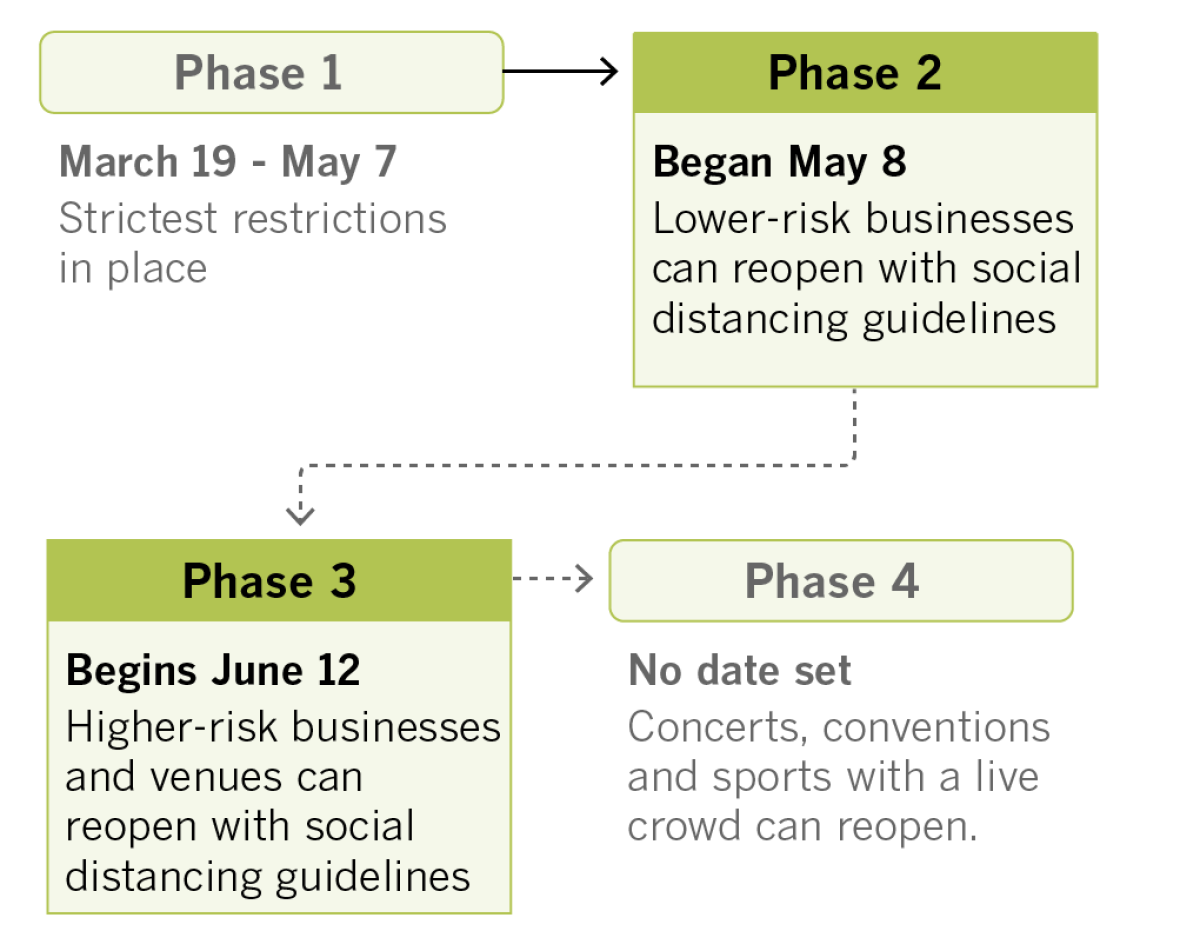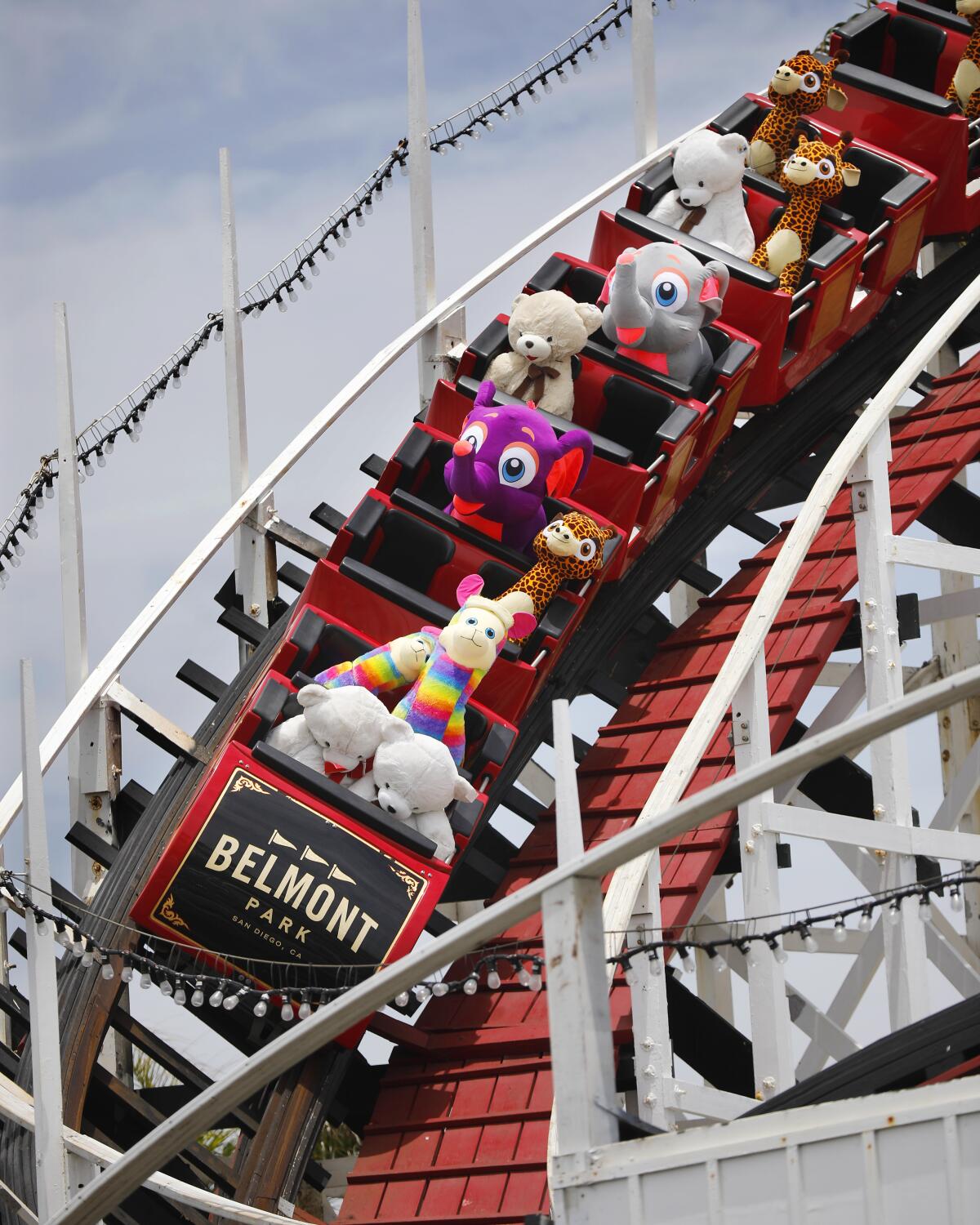Coronavirus Today: A disproportionate toll
- Share via
Good evening. I’m Diya Chacko, and it’s Wednesday, June 3. Here’s what’s happening with the coronavirus in California and beyond.
Health experts have long warned of a potential second wave of coronavirus infections as the economy reopens. While other states have seen the first wave fade, a Times analysis shows that the number of weekly cases in California keeps rising, exceeding 17,000 for the first time last week. It can take three to four weeks after exposure for infected people to be hospitalized, and four to five weeks after exposure for patients to die from COVID-19.
The disease has already taken a disproportionate toll on black Californians, data show. As crowds fill the streets to protest yet another police killing of an unarmed black man, many are worried that people of color will also bear the brunt of new infections. But for protesters, staying home is not a choice they feel they can make. “I’ve spent the last several months of my life imploring and exhorting people to protect themselves, to reduce the spread of this virus and save lives,” said a black cardiologist. “It dawned on me that my greatest risk is not COVID-19. It’s the color of my skin.”
As the protests continued Wednesday, Los Angeles County extended its sweeping curfew, this time starting later. For local restaurants already reeling from more than two months of takeout-only during the pandemic, curfews have further complicated attempts to fully reopen. In some cases over the weekend, the curfews were issued only a few hours in advance, leaving restaurant owners scrambling. “It’s a mess, it’s totally confusing,” said the manager of an L.A. restaurant. “We have as little information as the customers do.”
With states reopening and people going back to work, demand for antibody tests has skyrocketed — and companies are popping up to meet it at exorbitant prices. It’s prompted the Food and Drug Administration to try to rein in what several infectious disease experts called “the wild, wild West” of COVID-19 antibody testing. Experts say even the best tests can’t yet answer the crucial question of whether antibodies confer immunity from future infections. “It’s outrageous that people were trying to make money off of this fear,” said the head of a San Francisco research institute.
Other businesses are finding ways to help rather than hinder the battle against COVID-19. A visual effects studio in Hollywood has created a tool that compiles data on the coronavirus’ structure into a digital display that could further scientists’ understanding on how to fight it. “It was just super cool to see that there are these tools available that are being used in movies in Hollywood that could be brought to bear to biomedical problems,” said the scientist who worked with the studio.
One treatment that new research suggests scientists can rule out is the anti-malarial drug hydroxychloroquine. The most eagerly anticipated study on its effectiveness has found it worthless at preventing COVID-19. That drug and a similar one had ignited much debate when President Trump began promoting and later taking it, causing a craze that created shortages for patients who use it to treat lupus and other diseases. “While we are disappointed that this did not prevent COVID-19, we are pleased that we were able to provide a conclusive answer,” said the study’s lead researcher.
By the numbers
California cases and deaths as of 5:21 p.m. PDT Wednesday:

Track the latest numbers and how they break down in California with our graphics.

See which counties are reopening with our tracker.
Across California
To protect against the spread of the coronavirus, Gov. Gavin Newsom gave California counties permission on Wednesday to limit in-person voting operations for the Nov. 3 election — but only if they also offer three days of early voting. The majority of California’s 58 counties still conduct elections with in-person ballots cast on election day at neighborhood polling places — but some of them are as small as a house’s garage, making safe physical distancing impossible. The cost to implement the latest guidelines could be substantial, further straining county budgets.
Newsom’s revised budget expects legal marijuana sales to drop this year, despite an initial spike in consumer demand after dispensaries were deemed essential. “Cannabis businesses have less access to banking services that could provide liquidity, have a younger consumer base likely to be disproportionately affected by the COVID-19 recession, and still must contend with competition from the black market,” the budget says. To help, Newsom has relaxed some restrictions on how cannabis firms operate, deferred license renewal fees and extended the first-quarter tax-filing deadline.
The damage done by keeping children out of school might outweigh the risks of the coronavirus, the Southern California chapter of the American Academy of Pediatrics says, pointing to research that suggests the risks of COVID-19 transmission among children are lower than for adults. But L.A. Unified School District Supt. Austin Beutner said Wednesday that returning to school in any capacity would be risky without treatment or a vaccine, since kids’ vulnerable family members and school employees could also be infected.
USC will bring students back to campus in the fall with safety measures that include both online and in-person classes, more spacing in dorms and testing for COVID-19. It’s one of the first major universities in California to announce concrete reopening plans; the University of California system is expected to announce plans for its 10 campuses later this month. The decision comes as some USC students were considering gap years and balking at paying $58,000 for online learning.
Like many tourist attractions, the Giant Dipper roller coaster at Belmont Park in San Diego’s Mission Beach is closed to the public. But the historic roller coaster couldn’t just shut down; it required operating multiple times a day to keep its machinery from tightening up for lack of use. Rather than have the six-car coaster train barrel down the tracks with empty seats every day, its operators decided to strap in some riders who are immune to the virus: stuffed animals.

Resources
— For general safety, wash your hands for at least 20 seconds (here’s a super-fun how-to video). Stop touching your face, and keep your phone clean. Practice social distancing, maintaining a six-foot radius of personal space in public. And wear a mask if you leave home. Here’s how to do it right.
— Watch for symptoms including fever, cough, shortness of breath, chills, repeated shaking with chills, muscle pain, headache, sore throat and loss of taste or smell. If you’re worried you might be infected, call your doctor or urgent care clinic before going.
— Here’s how to care for someone with COVID-19, from monitoring their symptoms to preventing the virus’ spread.
— If your job has been affected by the coronavirus pandemic, here’s how to file for unemployment.
— Here are some free resources for restaurant workers and entertainment industry professionals having trouble making ends meet.
— Advice for helping kids navigate pandemic life includes being honest about uncertainties, acknowledging their feelings and sticking to a routine. Here’s guidance from the CDC.
— In need of mental health services? Here are resources for coping during the crisis from the CDC and the L.A. County Department of Public Health. L.A. County residents can also call (800) 854-7771 or text “LA” to 741741.
Around the nation and the world
By some projections, states’ budget shortfalls across the country are estimated to reach $765 billion over the next three years. Governors from Michigan, Colorado and Arkansas warned congressional leaders of the outcomes of those shortfalls at a virtual hearing Tuesday, with Michigan Gov. Gretchen Whitmer saying that the money was needed for public health, safety and education. “The bottom line is that we need additional flexibility and additional resources,” she said.
Although subdued by protests, much of Las Vegas is expected to spring to back life on Thursday, with Caesar’s Entertainment saying it would open not only Caesars Palace and Flamingo but also Harrah’s Las Vegas. Fifteen other hotel-casinos — still fewer than half of the 35 or so resorts along the Strip — are expected to open by the weekend with new protective measures. Expect masked workers frequently disinfecting everything from craps tables to slot machines to elevator buttons, and Plexiglas barriers everywhere. And if you’re planning to ride New York-New York’s Big Apple Coaster, expect to sit alone.
With many leagues making moves to restart games, including Major League Soccer in early June and the NBA by July 31, TV sports is set to return with a jam-packed fall. One possible downside is a logjam of events that may fragment audiences and spread advertising dollars too thin, but sports media executives say they’re not too worried. “There is a tremendous pent-up desire to see sports,” said the chairman of WarnerMedia News and Sports.
Your questions answered
Today’s question comes from readers who want to know: When will cruises resume sailing? Here’s an update from The Times’ Travel team.
The pandemic left dozens of cruise ships temporarily stranded at sea, not allowed to dock because of onboard outbreaks of the coronavirus. But would-be travelers are still anxious to know when cruise lines might begin to sail again.
U.S.-based American Cruise Lines is planning to sail June 20, more than a month before the June 24 expiration of the “no-sail order” issued by the Centers for Disease Control and Prevention. The luxury line’s fleet of 12 ships carry 100 to 190 passengers, small enough to qualify under a CDC regulation that specifies the no-sail order “applies to passenger-carrying vessels ... with the capacity to carry 250 or more individuals (passengers and crew).”
In addition, the ships “are all voluntarily sailing at 75% capacity,” a spokesperson said.
Other companies, including Disney Cruises, Royal Caribbean and Norwegian Cruise Line, have announced sailing dates in late July and early August or later, but they are subject to change.
Got a question? Our reporters covering the coronavirus outbreak want to hear from you. Email us your questions, and we’ll do our best to answer them. You can find more answers in our Frequently Asked Questions roundup and on our coronavirus roundup page.
For the most up-to-date coronavirus coverage from The Times, visit our homepage and our Health section, listen to our “Coronavirus in California” podcast and follow us on Twitter and on Instagram.




